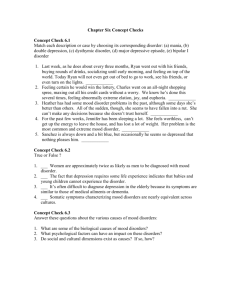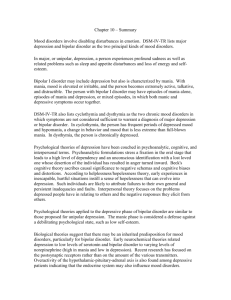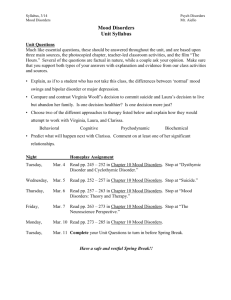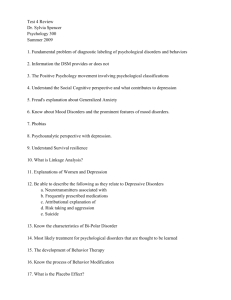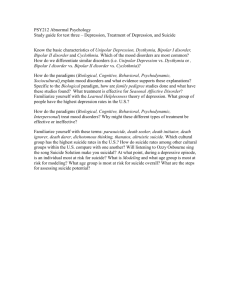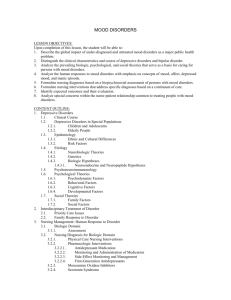baptist health schools of nursing
advertisement
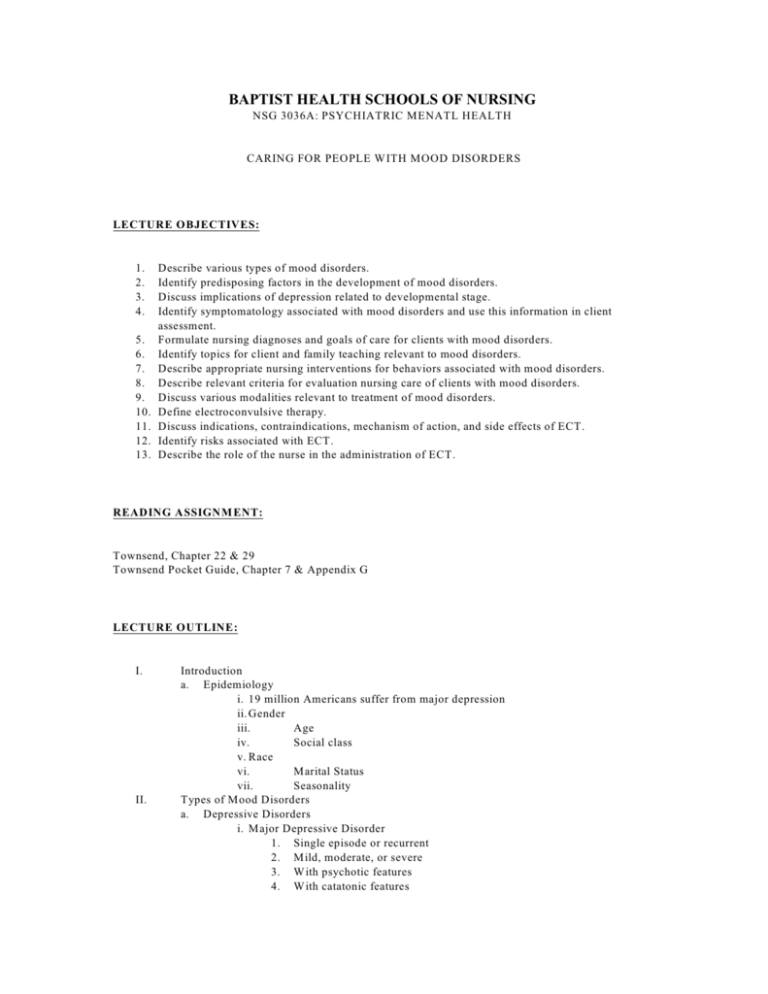
BAPTIST HEALTH SCHOOLS OF NURSING NSG 3036A: PSYCHIATRIC MENATL HEALTH CARING FOR PEOPLE W ITH MOOD DISORDERS LECTURE OBJECTIVES: 1. 2. 3. 4. 5. 6. 7. 8. 9. 10. 11. 12. 13. Describe various types of mood disorders. Identify predisposing factors in the development of mood disorders. Discuss implications of depression related to developmental stage. Identify symptomatology associated with mood disorders and use this information in client assessment. Formulate nursing diagnoses and goals of care for clients with mood disorders. Identify topics for client and family teaching relevant to mood disorders. Describe appropriate nursing interventions for behaviors associated with mood disorders. Describe relevant criteria for evaluation nursing care of clients with mood disorders. Discuss various modalities relevant to treatment of mood disorders. Define electroconvulsive therapy. Discuss indications, contraindications, mechanism of action, and side effects of ECT. Identify risks associated with ECT. Describe the role of the nurse in the administration of ECT. READING ASSIGNM ENT: Townsend, Chapter 22 & 29 Townsend Pocket Guide, Chapter 7 & Appendix G LECTURE OUTLINE: I. II. Introduction a. Epidemiology i. 19 million Americans suffer from major depression ii. Gender iii. Age iv. Social class v. Race vi. Marital Status vii. Seasonality Types of Mood Disorders a. Depressive Disorders i. Major Depressive Disorder 1. Single episode or recurrent 2. Mild, moderate, or severe 3. W ith psychotic features 4. W ith catatonic features III. 5. W ith melancholic features 6. Chronic 7. W ith seasonal pattern 8. W ith postpartum onset ii. Dysthymic Disorder 1. Early onset 2. Late onset iii. Premenstrual dsyphoric disorder 1. Depressed mood 2. Marked anxiety 3. Mood swings 4. Decreased interest in activities during the week prior to menses and subsiding shortly after the onset of menstruation. b. Bipolar Disorders i. Bipolar I Disorder ii. Bipolar II Disorder iii. Cyclothymic Disorder c. Other mood disorders i. Due to a medical condition ii. Substance induced mood disorder Depressive Disorders a. Predisposing factors i. Biological theories 1. Genetics 2. Biochemical influences 3. Neuroendocrine disturbances 4. Physiological Influences a. Medication side effects b. Neurological disorders c. Electrolyte disturbances d. Hormonal disturbances e. Nutritional deficiencies f. Other physiological conditions ii. Psychosocial theories 1. Psychoanalytical theory a. Freud 2. Learning theory a. Learned helplessness 3. Object-loss theory 4. Cognitive theory b. Developmental implications i. Childhood depression ii. Adolescent depression iii. Senescence iv. Postpartum depression c. Application of the Nursing Process to Depressive Disorders i. Background Assessment Data 1. Degree of Severity a. Transient depression b. Mild depression c. Moderate depression d. Severe depression 2. Nursing Diagnoses 3. Nursing Intervention a. Protection from harming self b. Assisting with progression through the grief process c. d. IV. V. Enhancing client self-esteem Helping the client determine ways to take control over his or her life e. Assistance in confronting anger that has been turned inward on the self f. Ensuring that needs related to nutrition, elimination, activity, rest, and personal hygiene are met g. Client/family education 4. Evaluation Bipolar Disorder (Mania) a. Predisposing Factors i. Biological theories 1. Genetics 2. Biochemical influences 3. Electrolytes 4. Physiological influences ii. Psychosocial theories 1. Psychoanalytical theory 2. Theory of family dynamics 3. Transactional model b. Application of the Nursing Process to Bipolar Disorder i. Background assessment data 1. Degree of severity a. Stage I: Hypomania: symptoms not sufficiently severe to cause marked impairment in social or occupational functioning or to require hospitalization b. Stage II: Acute mania: Marked impairment in functioning of mood, cognition, and perception, and activity and behavior. Usually requires hospitalization c. Stage III: Delirious mania: A grave form of the disorder characterized by severe clouding of consciousness and representing an intensification of the symptoms associated with acute mania ii. Nursing diagnoses iii. Nursing interventions 1. Protection from injury due to hyperactivity 2. Protection from harm to self or others 3. Restoration of nutritional status 4. Progression toward resolution of the grief process 5. Improvement in interactions with others 6. Acquiring sufficient rest and sleep 7. Client/family education iv. Evaluation c. Treatment Modalities for Mood Disorders i. Psychological Treatments 1. Individual Psychotherapy 2. Group Therapy 3. Family Therapy 4. Cognitive Therapy ii. Organic Treatments 1. Psychopharmacology 2. Electroconvulsive therapy Electroconvulsive Therapy a. Historical Perspectives i. Insulin coma therapy ii. IM injections of camphor in oil b. c. d. e. f. g. h. iii. Acceptance iv. Estimated 50,000 to 100,000 people in the US receive ECT treatment per year Definition i. The induction of a grand mal (generalized) seizure through the application of electrical current to the brain. Electrodes are placed on the frontotemporal region either unilaterally or bilaterally. Stimulation is based on the patient’s seizure threshold. The seizure duration should be at least 25 seconds. ii. Required treatments are an average of 6 to 12, but may be as many as 20. Treatments are administered every other day, three times a week. Indications i. Severe Depression ii. Acute manic episodes of Bipolar affective disorder iii. Can induce a remission in some clients who present with acute schizophrenia Contraindications i. The only ABSOLUTE is increased intracranial pressure (from brain tumor, recent CVA, or Cerebrovascular lesion) ii. High risk patients include: Myocardial infarction or CVA within the preceding 3 months, aortic or cerebral aneurysm, severe underlying hypertension, or CHF. Mechanism of Action i. Unknown. Credibility has been given to the biochemical theory which suggests there is a result in significant increases in the circulating levels of serotonin, norepinephrine, and dopamine. Side Effects i. Temporary memory loss and confusion Risks i. Mortality ii. Permanent memory loss iii. Brain damage Role of the nurse i. Thorough physical examination 1. Assessment of cardiovascular and pulmonary status 2. Labs on blood and urine 3. Skeletal history and X-ray should be considered ii. Informed consent iii. Assess mood, level of anxiety, thought and communication patterns, and vital signs. iv. Have the patient void, remove dentures, eyeglasses or contact lenses, remove jewelry, and hairpins. v. According to M D’s orders, Atropine sulfate or Robinul are given 30 minutes prior to the procedure vi. In the treatment room, the anesthesiologist administers a muscle relaxant and a short acting anesthetic (Brevital). vii. The client is receiving oxygen during and after treatment viii. An airway/bite block is used to facilitate airway patency. Electrodes are placed on the temples to deliver the electrical stimulation. ix. Assist the psychiatrist and the anesthesiologist as required x. Provide emotional and physical support to the client xi. After treatment, remain with the client until fully awake. Vital signs are taken every 15 minutes for the first hour. Orient the client to time and place and give them an explanation of what has occurred.
